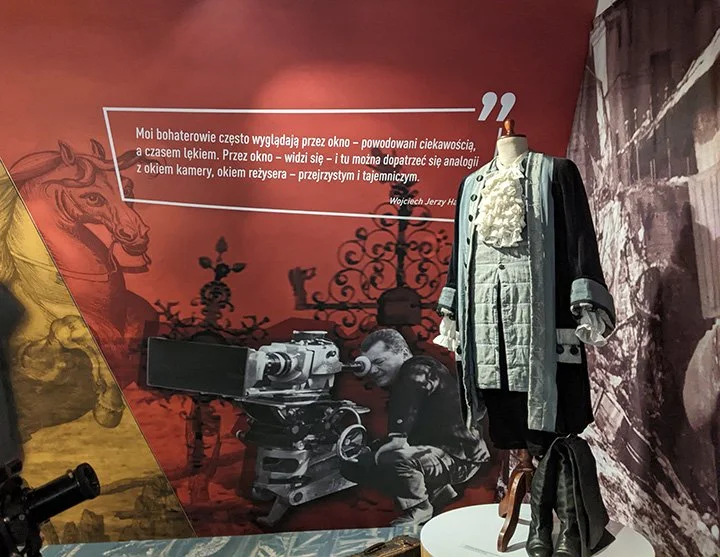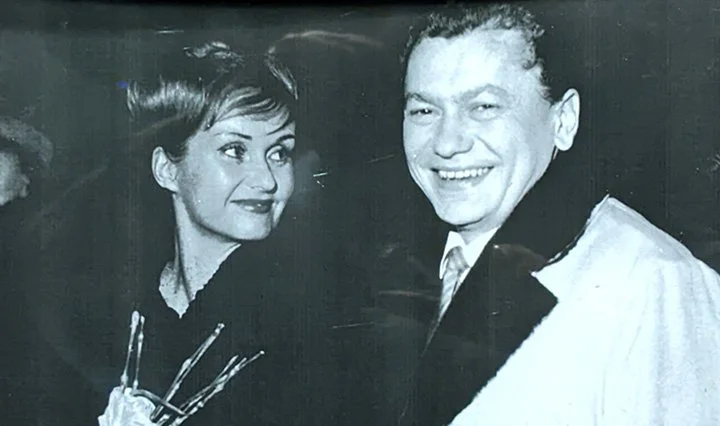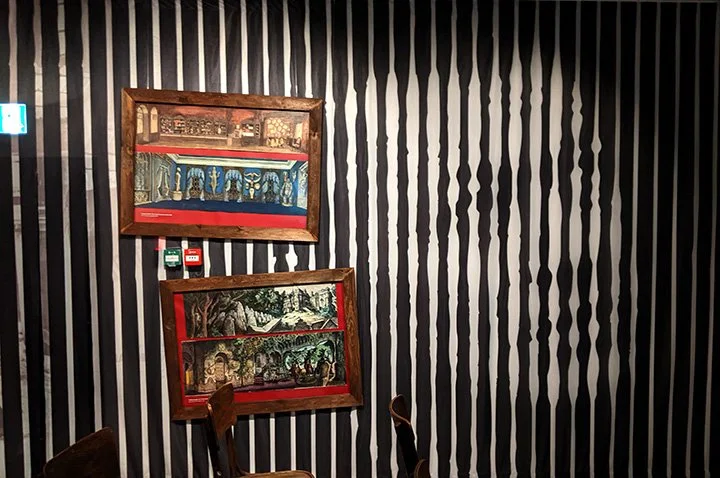Between Word and Image – The Literary Inspirations of Wojciech Jerzy Has
/“Has’s Journeys,” exhibition at the National Center for Film Culture in Łódź, August 2025, photo by J. Sokołowska-Gwizdka
The work of Wojciech Jerzy Has represents one of the most beautiful encounters between literature and cinema in the history of Polish culture. A director endowed with an extraordinary visual imagination and a deep sensitivity to the written word, Has was able to translate prose into the language of images in a profoundly original way. His films are not faithful illustrations of literary works—they are poetic interpretations, painterly records of emotion, memory, and imagination. Has did not so much adapt literature as he painted it with light and shadow, transforming words into metaphors and stories into dreams.
Cinema Rooted in Literature
It is no coincidence that most of Has’s films are adaptations of Polish and world literary classics. Yet, the director did not treat the literary text as a ready-made screenplay, but rather as material for personal interpretation. In his films, prose becomes a starting point for philosophical reflection on the world, memory, and the human condition.
In The Manuscript Found in Saragossa (based on the novel by Jan Potocki), Has created a labyrinth of stories, where one tale gives birth to another, and dream blends with reality. In The Hourglass Sanatorium (after Bruno Schulz)—a visual masterpiece—the world of literary metaphor was translated into images of extraordinary plasticity. Each scene resembles a painting: dense, saturated with color, light, and texture.
Similarly, in The Codes (based on Andrzej Kijowski’s prose) and How to Be Loved (after Kazimierz Brandys), Has explored the relationships between past and present, memory and oblivion, giving them a universal dimension. In his hands, literature becomes a spiritual vehicle—a tool for delving into the depths of the human condition.
Image as Memory
Wojciech Has was an aesthete and a collector. In his films, every object—a faded photograph, a clock, a book, a folding fan—carries symbolic weight. It is the things that speak for people, for in them memory is preserved. Has’s camera not only tells a story but also observes and touches. The lens glides over the texture of fabrics, furniture, dust, and smoke, creating a world that feels almost tangible, rich in sensual detail.
In this sense, Has was a continuator of the painterly tradition of the Polish Film School—closely linked to 19th-century and Art Nouveau painting, with its attention to ornament and detail. Each of his films is a visual poem, where aesthetics serve not decoration but metaphor. His frames evoke the canvases of Hieronymus Bosch or Vermeer—mysterious, precise, and multilayered.
“Has’s Journeys,” exhibition at the National Center for Film Culture in Łódź, August 2025, photo by J. Sokołowska-Gwizdka
The World in the Mirror of Illusion
Has’s world is one of illusion, reflection, and dream. The director leads the viewer into an uncertain space, where time loses its linear quality. The protagonists of his films wander like in a labyrinth of memories, searching for meaning in the chaos of events. Has created a cinema of melancholy—filled with reflection on transience, the impossibility of recreating the past, and the loneliness of man within a world of symbols.
In this sense, film becomes for him a philosophical meditation, and image—a tool of understanding. As the director himself wrote, “Film is like a dream from which we do not wish to wake.”
The Legacy of a Visual Poet
The work of Wojciech Jerzy Has remains one of the most important chapters in the history of Polish art cinema. His films—with their union of literary depth and refined visual form—continue to inspire filmmakers around the world. In an age when cinema is often ruled by spectacle and plot, Has reminds us that the image can carry spiritual meaning.
He was a poet of cinema, painting with light and shadow. His frames—like the words of Schulz or Potocki—never age, for they touch what is timeless in the human soul: the longing for beauty, memory, and meaning.
„Has’s Journeys,” exhibition at the National Center for Film Culture in Łódź, August 2025, photo by J. Sokołowska-Gwizdka
Compiled by Joanna Sokołowska-Gwizdka
Films Directed by Wojciech Jerzy Has
The Noose (1957)
Based on the short story by Marek Hłasko.
A moving portrait of a man struggling with addiction and loneliness, unfolding over the course of a single day. Has preserved the psychological depth of Hłasko’s prose, giving it the rhythm of cinematic breathing.
Farewells (1958)
Based on the novel by Stanisław Dygat.
A coming-of-age story of a young intellectual during wartime, imbued with melancholy and irony. The film depicts the loss of illusions and the passing of youth—a theme close to both Dygat and Has.
Shared Room (1959)
Based on the novel by Zbigniew Uniłowski.
A portrait of the Warsaw bohemia of the 1930s, with its poverty, dreams, and restlessness. Has captures the atmosphere of the literary original with remarkable tenderness, creating a film about the disillusionments of a young generation.
Goodbye to the Past (1960)
Based on the short story by Stanisław Dygat.
A subtle tale of the end of love, rendered in a tone of reflection and sorrow. The film is also a poetic study of the transience of feelings and memories.
Gold (1962)
Based on the short story by Józef Hen.
The story of treasure hunters in post-war Lower Silesia. Has transforms Hen’s prose into a moral parable about human greed and the longing for redemption.
Barbara Krafftówna and Wojciech Has after the gala premiere of the film How to Be Loved on January 11, 1963, at the Moskwa Cinema in Warsaw. Photo by Jerzy Troszczyński, source: exhibition Has’s Journeys.
How to Be Loved (1963)
Based on the short story by Kazimierz Brandys.
One of the greatest achievements of Polish psychological cinema. A woman who has survived the war returns to her memories. Has creates a film about memory, guilt, and solitude, in which literature becomes a confession of the soul.
The Manuscript Found in Saragossa (1964)
Based on the novel by Jan Potocki.
A masterpiece of world cinema—a baroque labyrinth of stories where reality mingles with fantasy. Has brought the novel’s multilayered structure to the screen with extraordinary visual mastery.
The Codes (1966)
Based on the short story by Andrzej Kijowski.
An intimate drama of a father and son trying to rebuild their bond after the war. Has presents the past as a space of uncertainty and silence, where every word carries the weight of mystery.
The Doll (1968)
Based on the novel by Bolesław Prus.
One of the most complete adaptations of a literary classic. In Has’s interpretation, Wokulski becomes a symbol of a man torn between love and reason, ideal and reality. The film enchants with its visual richness and psychological subtlety.
Exhibition “Has’s Journeys”
The Hourglass Sanatorium (1973)
Based on the stories by Bruno Schulz.
A poetic dream about time, memory, and death. Has transformed Schulz’s prose into a visual poem, where the world of objects and memories comes alive within the magical space of a dream.
From Nowhere to Nowhere (1975)
Original screenplay by the director, spiritually inspired by the works of Fyodor Dostoevsky and Bruno Schulz.
A metaphorical film about human confusion and the search for meaning in a purposeless world. Here, Has fuses philosophy and the poetry of the image.
An Uninteresting Story (1983)
Based on the short story by Anton Chekhov.
An intimate study of an aging professor taking stock of his life. With remarkable delicacy, Has portrays the drama of lost purpose and spiritual exhaustion.
Memoirs of a Sinner (1985)
Loosely inspired by the prose of Jerzy Harasymowicz.
An introspective tale of guilt and confession of the soul. Has creates a visual world of symbols and memories, where the boundary between dream and reality nearly disappears.
The Tribulations of Balthazar Kober (1988)
Based on the novel by Frédérick Tristan.
Has’s final film—a philosophical parable about a man seeking truth and meaning in a world filled with illusion. A mystical, masterfully photographed journey through the realms of knowledge and faith.
„Has’s Journeys,” exhibition at the National Center for Film Culture in Łódź, August 2025, photo by J. Sokołowska-Gwizdka



















